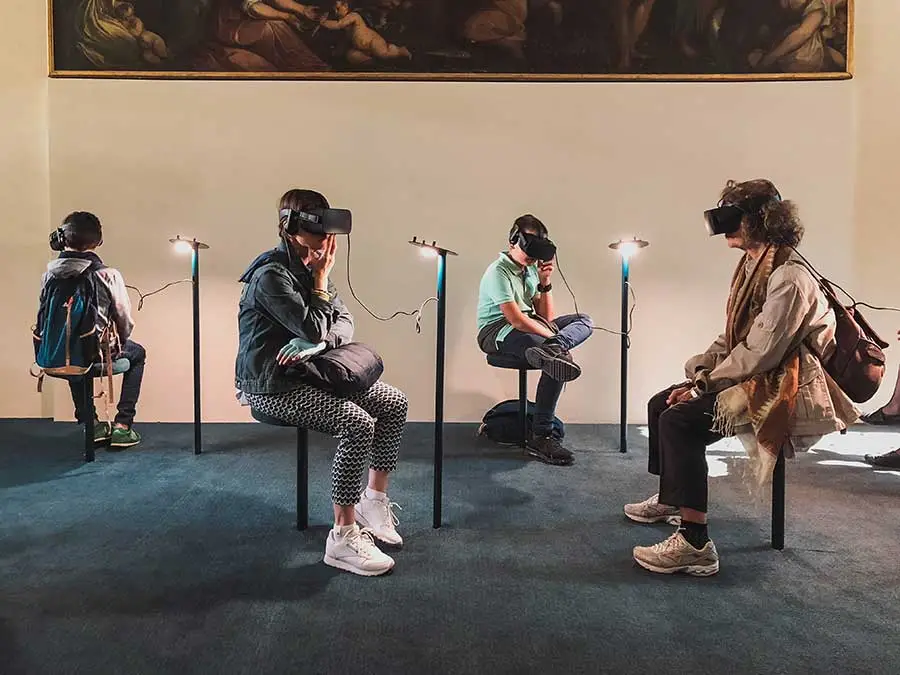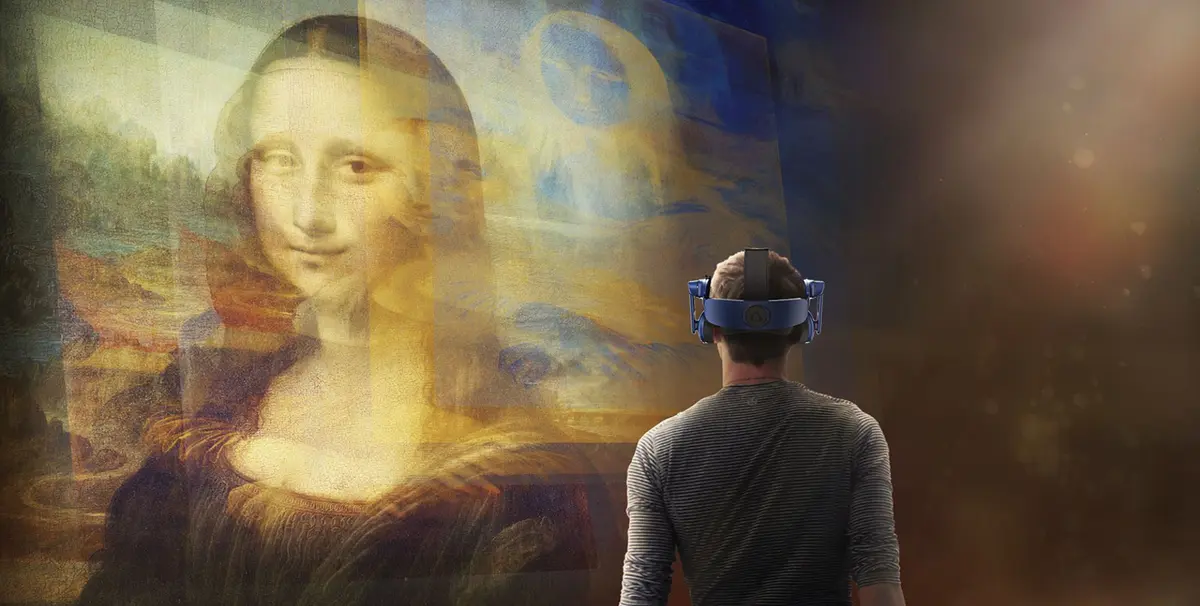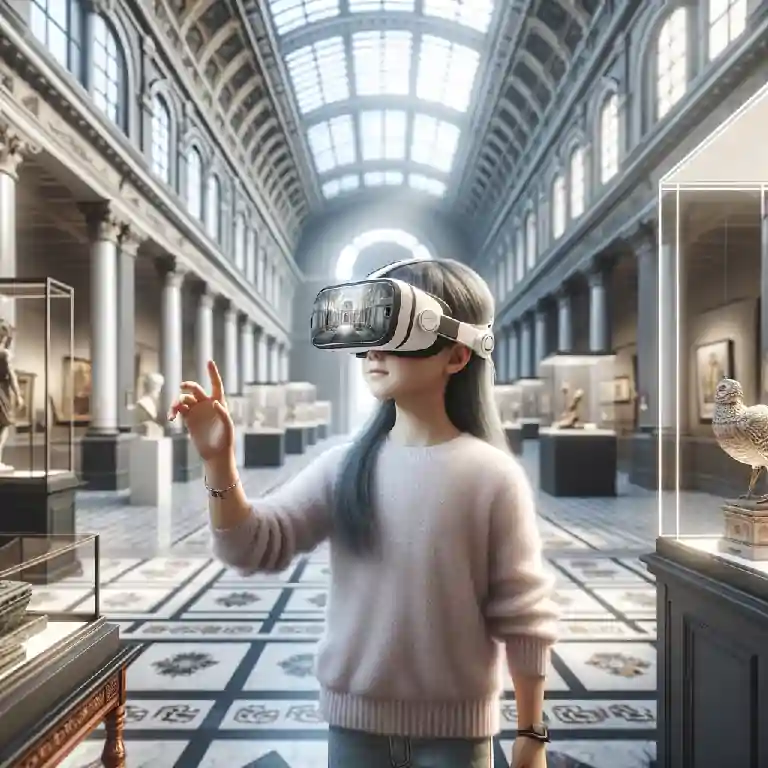- VR in museums act like digital time machines, whisking you to the Louvre without the crowds.
- Challenges abound: High-tech hurdles, content creation conundrums, and the quest for inclusivity.
- Beyond boundaries: Museums of the future, where culture meets innovation, and everyone’s invited.
A cultural revolution or a digital mirage? The use of technology in museums has not always been accepted by those who treasure the old and the static. But in museums scattered across the globe, each painting, antique, and historical artefact tells a unique tale that in recent decades, and increasingly in recent years, tech has helped spread to the world.
For many, museums are magical places for delving into the past and understanding the present. Yet, admittedly, for others, traditional museums can seem like dust-covered capsules of time, lacking allure, even bordering on tedium. However, with the rapid advancement of virtual reality technology, the once static walls of museums are coming to life, transforming into vibrant, multi-dimensional cultural universes.
In this emerging digital realm, ancient relics and historical narratives are imbued with new life. Visitors are no longer mere onlookers; they become participants and explorers of history. They can traverse to the pyramids of ancient Egypt, listen to Shakespeare’s plays, or find themselves in the galleries of the Renaissance. These immersive experiences not only make history and culture more accessible but ignite a previously unparalleled thirst for knowledge and love for art in people. Virtual reality is opening windows to the past, turning each museum visit into a vivid, unforgettable adventure.
Also read: XR through the years: From the nausea-inducing Virtual Boy, to Apple’s era-defining Vision Pro
Museums, not just imagination
Museums, in their traditional form, have long been the custodians of history, art, and culture. Yet, as James Durston pointed out in his article “Why I Hate Museums,” the conventional museum experience often leaves some feeling disenchanted. Durston’s critical view of museums highlights a sentiment echoed by others: that museums, with their seemingly unapproachable and static exhibits, can sometimes feel detached and uninspiring. This has sparked a debate around the fundamental role and purpose of museums. While some argue that museums should be about enlightenment, inspiration, or quiet reflection, others lament their lack of engagement and entertainment value.
In response to these criticisms and evolving public expectations, museums are now at the forefront of a technological revolution, embracing the powers of Virtual Reality (VR), Augmented Reality (AR), and Extended Reality (XR). This new wave of technology is not just a fleeting trend but a profound transformation in how we interact with and perceive history and culture. These technologies are reshaping museums from static halls of the past into dynamic, interactive spaces where history and art leap off the walls and come to life.
This shift represents more than just a technological upgrade; it’s a reimagining of the museum experience. It acknowledges the diverse ways people engage with and learn from their surroundings. By integrating VR, AR, and XR, museums are not only addressing the criticisms of individuals like Durston but are also expanding their reach and relevance in a rapidly changing world. The new museum experience is no longer confined to physical boundaries; it’s an expansive, immersive journey that caters to the imagination and curiosity of each visitor, making every encounter with history a personal and engaging adventure.
Michael A. Di Giovine, Director of the West Chester University Museum of Anthropology and Archaeology, highlights the broader implications of this technological shift: “In a world currently fraught with pandemic, climate change threats and warfare, as well as the push-pull of over-tourism and under-tourism, these technologies can greatly enhance accessibility and interactivity of tangible and intangible cultural heritage.” This perspective emphasizes the potential of emerging technologies to make cultural heritage more accessible and interactive, particularly in a world facing numerous challenges.
Also read: 9 very different ways AI is changing the world
Virtual ventures: Embracing diversity in the digital domain

In this digital epoch, museums are undergoing a metamorphosis from quiet corridors of history into dynamic virtual reality realms, bridging the chasm between the traditional and the contemporary. This transformation revitalises museum exhibits and draws an audience who might never have ventured into a museum previously. As Michael A. Di Giovine elucidated in an interview with BTWmedia: “Several individuals I’ve conversed with expressed their fondness for virtual tours due to their heightened social anxiety and their reluctance to frequent spaces with substantial crowds. The facility to visit virtually assures that they can engage with the exhibition or site devoid of the stress or anxiety that would otherwise impede their focus.”
Envisage someone with an aversion to crowds, now capable of perusing museums globally from the sanctuary of their settee, donning a VR headset. They can delve into the depths of the Louvre or meander through the halls of the British Museum, all sans any pressure. This transcends a mere museum visit; it is a cultural odyssey, a voyage of the mind.
For those constrained by physical disabilities, geographical limitations, or other impediments, the application of virtual reality holds immense significance. They are now able to surmount physical barriers and intimately engage with cultural heritage and artworks from afar. A holidaymaker lounging on a beach in Australia could be savouring the marvels of the Metropolitan Museum of New York through VR spectacles.
The incorporation of virtual reality is not solely an innovation in the manner museums present exhibits, but a broadening of their societal mission and cultural duty. Museums have transformed from being exclusive sanctuaries of knowledge for a select few to becoming global, open, and inclusive platforms for cultural exchange. On this platform, each individual can become an explorer, partaking in a distinctive dialogue with history.
Pop quiz
How are museums adapting to address criticisms and evolving public expectations?
A. By removing exhibits altogether.
B. By embracing Virtual Reality (VR) and Augmented Reality (AR).
C. By increasing admission fees.
D. By reducing their reach and relevance.
The answer is at the bottom of this article.
Virtual reality in museums: Balancing opportunities and challenges
As virtual reality technology reshapes the museum experience, it also presents a unique double-edged sword effect, simultaneously creating opportunities and challenges. This is particularly evident in the issue of museum carrying capacity. With the physical space of museums being fixed and their capacity limited, different types of museums face varying challenges and opportunities.
Firstly, consider museums suffering from a lack of visitors. VR acts like a panacea, allowing them to showcase their treasures even in times of scarce footfall. On the other hand, for victims of overtourism, such as overburdened world heritage sites, VR offers an alternative method to alleviate on-site pressures.
However, the key question remains: Can a virtual reality experience truly equate to personally witnessing Michelangelo’s frescoes? Although VR offers a zero-carbon way of cultural travel, in line with environmental consciousness, can it fully replace the experience
of physically feeling the ambiance, scents, and textures of historical sites?
I do have to say, however, that some of my interviewees push back on this idea, and say that virtual tours take away from the full sensory experience of the site: technology has not yet been able to replicate the smells, the ambient sounds, the touch, and yes, even the stress of being in crowds, which create the holistic experience.
Michael Di Giovine ,the Director of the West Chester University Museum of Anthropology and Archaeology (www.wcupa.edu/museum) and our Museum Studies program
Moreover, we must also consider the maintenance costs and copyright issues associated with virtual reality technology. The creation of a VR exhibition may require substantial financial and technical investment. Does this risk creating a new form of cultural inequality? Can all museums around the world afford to jump on this technological bandwagon?
Thus, this discussion transcends mere technological advancement, evolving into a debate about cultural experience, sustainability, and equality. Will virtual reality redefine our conception of museums? Could it become the mainstream method for cultural exploration in the future? Or will it remain a supplementary tool, offering a glimpse of artistic allure when personal visits are not feasible?

Breaking boundaries: Virtual reality’s impact on museums and cultural equity
Integrating advanced technologies into the museum experience is akin to embarking on an exhilarating journey, but it’s not without its twists and turns. Beyond the technical hurdles and creative demands, a host of broader considerations unfurl.
Picture this: the need for high-quality VR headsets, a hefty investment both in terms of cost and availability, stands as a formidable roadblock. This begs the question of inclusivity – will these experiences be accessible to all or remain the privilege of a select few?
Then comes the challenge of content creation, an art that demands not just technical prowess but a profound understanding of art, history, and storytelling. Museums find themselves at a crossroads, needing to translate the physical magic of an on-site visit into a digital format without losing its essence.
User experience design takes center stage too. These virtual adventures must be intuitive, captivating, and easy to navigate, catering to both tech-savvy explorers and those taking their first steps into the world of VR. Striking the balance between technological marvel and user-friendliness becomes an art in itself.
But the canvas stretches further. Ensuring these virtual experiences are accessible to all is paramount. Museums grapple with the challenge of making these encounters user-friendly for those with physical disabilities or limited tech proficiency. It’s about making culture truly inclusive.
Looking ahead, the horizon is limitless. Augmented reality might soon lead us on interactive journeys through outdoor historical sites, while extended reality could transport us to lost historical wonders.
In closing, integrating technologies like virtual reality into the museum experience is an adventure filled with challenges and discoveries. As technology evolves and museums embrace these tools, we step into an era of cultural exploration that’s immersive, interactive, and open to all.
The correct answer to the pop quiz is B. By embracing Virtual Reality (VR) and Augmented Reality (AR).

